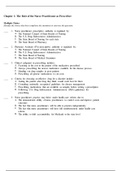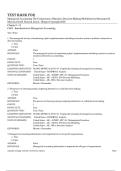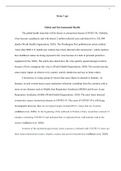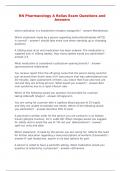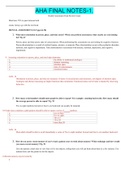Duty of Care
A number of elements:
1. Duty of care: The defendant (D) must have owed the claimant (C) a duty of care not to have caused
the type of harm suffered.
2. ‘Breach’ of that duty: D must have breached their duty towards C by behaving negligently.
3. Causation: D’s breach must have caused the harm that the C complains of and this damage must not
be too remote.
4. Actionable damage: The type of harm C alleges must ultimately be of the sort that the tort of
negligence actually protects against.
Needs to be on the list.
The elements overlap. Particularly because of the different ways in which foreseeability can play a role.
They are also intertwined- determining whether there has been a breach may require consideration of the
kind of damage as there might not be a duty to protect against all kinds of duty. For instance is there a
duty to protect against harm by third-parties or self-harm?
What is the duty of care?
MATTER OF LAW
A quintessentially common law feature of the common law of torts. Non-common law systems do not
have an easily identifiable corollary. A question of law. It is not a question of fact, it is for the judge to
decide and thus can provide the basis for negligence. Cases can be struck out or summary judgments
given in the event that there is no duty, since this is a matter of law. This is not appropriate in cases
where the law is developing.
Finding a duty of care in X means it is binding in all future cases involving the same facts. A duty is a
finding about an abstract relationship between all subsequent parties who stand in that relationship with
one another. Tied to the particular harm that is being complained of. For example may be hard to show a
duty of care where D has not acted.
Fault-based.nThe duty of care in negligence in any situation is a duty to take reasonable care (contrast
with so-called ‘Non-Delegable Duties’ in Semester 2).
DUTY MUST BE OWED TO THE CLAIMANT
Negligence “in the air” is not enough: the duty must be owed to the claimant themselves.
Even if a duty exists in the general sense it is necessary to establish that it is applicable to a particular set
of facts. Duty is linked to the causation element and it must be foreseeable that C would be a victim of
initial negligence.
FUNCTIONS OF DUTY
The notion of duty may be regarded as having two functions:
i. identifying whether a duty of care exists between the claimant and the defendant in a particular
the case.
ii. whether a duty can supersede the situation and if a general duty is to be found.
Duty does not tend to arise as often as an issue as most often cases of negligence are about a positive act
which causes physical damage to persons or property.
Lord Goff: “The broad general principle of liability for foreseeable damage is so widely applicable that
the function of the duty of care is not so much to identify cases where liability is imposed as to identify
those where it is not”
What is the point of duty as a concept?
Control of the scope of the law of negligence- cannot find negligence anywhere. A general duty of care
would be too onerous for the law to be practical
, It has been argued that the duty of care is not really a duty at all since it only becomes actionable in the
event that D acts unreasonably with respect to C’s interests.
‘The fifth wheel on the coach’ Professor Buckland
‘…historical accident’ Professor Winfield
Elements that the duty requirement deals with could be considered when other elements are address
idea that there is not a duty of care to victims in investigating criminal
behaviour, could be reallocated to the causation element with the criminal’s act being an intervening
cause.
Duty as a ‘control device’, per Professor Fleming. But controlling what? And how?
It allows for ‘strike-out’ proceedings. (Not having to go to court at all)
If there is no duty of care, there is no action in negligence, so D may argue a case on a ‘strike-out’ basis.
Many duty cases therefore are ‘bare’ legal questions about duty.
Duty, human rights and immunity
So, if D does not owe a duty of care, are they immune from tort liability?
This overlaps closely with the ‘boundaries’ of the tort of negligence’s applicability to the activities of
public authorities that concern allocation of resources or ‘policy’ decisions Smith v Ministry of
Defence (UKSC, 2014)
There were, historically, a number of actual immunities recognised but they have increasingly been
revoked or limited:
Crown Proceedings Act 1947 ss 1&2: Immunity of the Crown
Arthur Hall v Simmons (HL, 1980): Immunity of barristers
Jones v Kaney (HL, 2011): Immunity of expert witnesses
Mulcahy v MoD (1996): ‘Combat immunity’ upheld in Smith, even if narrowed
The development of the duty of care
Idea of negligence needing a ‘duty’ owed by D visible by the nineteenth century.
But it was not a generalised concept either:
…as to why there was a duty in a given case
…whether there should be a duty in a situation the court had never confronted, a so-called ‘novel’
duty situation.
Initial duties were pigeonholed such as doctor and patient (Gladwell v Steggall (1839)); employer and
employee (Smith v Baker & Sons (HL, 1891)) etc.
Relationship to contract was particularly problematic.
Winterbottom v Wright (1842): D did not owe P a duty of care by virtue of D having a contract with P’s
employer T to provide a safe and secure coach, which P was employed to drive and which, collapsed,
injuring P. Problem of certainty.
Odd rules emerged such as a duty where the items were ‘dangerous in themselves’ (Longmeid v
Holliday in 1851, an exploding lamp). Way of trying to get around the privity of contract which is
chaotic. How to categorise – duty not arising from a clear principle but from the issue itself.
Early attempts to provide a better, broader explanation based on principle: were not successful.
George v Skivington (1869): ropes
Heaven v Pender (1883)
‘…whenever one person is by circumstances placed in such a position with regard to another that
every one of ordinary sense who did think would at once recognise that if he did not use ordinary
care and skill in his own conduct with regard to those circumstances he would cause danger of injury
to the person or property of the other, a duty arises to use ordinary care and skill to avoid such
danger.’ [OD]
Per Brett MR who further tried to create a general principle in Le Lievre v Gould (1893) as the then Lord
Esher, but, again, unsuccessfully…
Donoghue: A fundamental breakthrough…eventually
Lord Atkin comes to Kings to give a speech in 1931 about a month before Donoghue was heard):
A number of elements:
1. Duty of care: The defendant (D) must have owed the claimant (C) a duty of care not to have caused
the type of harm suffered.
2. ‘Breach’ of that duty: D must have breached their duty towards C by behaving negligently.
3. Causation: D’s breach must have caused the harm that the C complains of and this damage must not
be too remote.
4. Actionable damage: The type of harm C alleges must ultimately be of the sort that the tort of
negligence actually protects against.
Needs to be on the list.
The elements overlap. Particularly because of the different ways in which foreseeability can play a role.
They are also intertwined- determining whether there has been a breach may require consideration of the
kind of damage as there might not be a duty to protect against all kinds of duty. For instance is there a
duty to protect against harm by third-parties or self-harm?
What is the duty of care?
MATTER OF LAW
A quintessentially common law feature of the common law of torts. Non-common law systems do not
have an easily identifiable corollary. A question of law. It is not a question of fact, it is for the judge to
decide and thus can provide the basis for negligence. Cases can be struck out or summary judgments
given in the event that there is no duty, since this is a matter of law. This is not appropriate in cases
where the law is developing.
Finding a duty of care in X means it is binding in all future cases involving the same facts. A duty is a
finding about an abstract relationship between all subsequent parties who stand in that relationship with
one another. Tied to the particular harm that is being complained of. For example may be hard to show a
duty of care where D has not acted.
Fault-based.nThe duty of care in negligence in any situation is a duty to take reasonable care (contrast
with so-called ‘Non-Delegable Duties’ in Semester 2).
DUTY MUST BE OWED TO THE CLAIMANT
Negligence “in the air” is not enough: the duty must be owed to the claimant themselves.
Even if a duty exists in the general sense it is necessary to establish that it is applicable to a particular set
of facts. Duty is linked to the causation element and it must be foreseeable that C would be a victim of
initial negligence.
FUNCTIONS OF DUTY
The notion of duty may be regarded as having two functions:
i. identifying whether a duty of care exists between the claimant and the defendant in a particular
the case.
ii. whether a duty can supersede the situation and if a general duty is to be found.
Duty does not tend to arise as often as an issue as most often cases of negligence are about a positive act
which causes physical damage to persons or property.
Lord Goff: “The broad general principle of liability for foreseeable damage is so widely applicable that
the function of the duty of care is not so much to identify cases where liability is imposed as to identify
those where it is not”
What is the point of duty as a concept?
Control of the scope of the law of negligence- cannot find negligence anywhere. A general duty of care
would be too onerous for the law to be practical
, It has been argued that the duty of care is not really a duty at all since it only becomes actionable in the
event that D acts unreasonably with respect to C’s interests.
‘The fifth wheel on the coach’ Professor Buckland
‘…historical accident’ Professor Winfield
Elements that the duty requirement deals with could be considered when other elements are address
idea that there is not a duty of care to victims in investigating criminal
behaviour, could be reallocated to the causation element with the criminal’s act being an intervening
cause.
Duty as a ‘control device’, per Professor Fleming. But controlling what? And how?
It allows for ‘strike-out’ proceedings. (Not having to go to court at all)
If there is no duty of care, there is no action in negligence, so D may argue a case on a ‘strike-out’ basis.
Many duty cases therefore are ‘bare’ legal questions about duty.
Duty, human rights and immunity
So, if D does not owe a duty of care, are they immune from tort liability?
This overlaps closely with the ‘boundaries’ of the tort of negligence’s applicability to the activities of
public authorities that concern allocation of resources or ‘policy’ decisions Smith v Ministry of
Defence (UKSC, 2014)
There were, historically, a number of actual immunities recognised but they have increasingly been
revoked or limited:
Crown Proceedings Act 1947 ss 1&2: Immunity of the Crown
Arthur Hall v Simmons (HL, 1980): Immunity of barristers
Jones v Kaney (HL, 2011): Immunity of expert witnesses
Mulcahy v MoD (1996): ‘Combat immunity’ upheld in Smith, even if narrowed
The development of the duty of care
Idea of negligence needing a ‘duty’ owed by D visible by the nineteenth century.
But it was not a generalised concept either:
…as to why there was a duty in a given case
…whether there should be a duty in a situation the court had never confronted, a so-called ‘novel’
duty situation.
Initial duties were pigeonholed such as doctor and patient (Gladwell v Steggall (1839)); employer and
employee (Smith v Baker & Sons (HL, 1891)) etc.
Relationship to contract was particularly problematic.
Winterbottom v Wright (1842): D did not owe P a duty of care by virtue of D having a contract with P’s
employer T to provide a safe and secure coach, which P was employed to drive and which, collapsed,
injuring P. Problem of certainty.
Odd rules emerged such as a duty where the items were ‘dangerous in themselves’ (Longmeid v
Holliday in 1851, an exploding lamp). Way of trying to get around the privity of contract which is
chaotic. How to categorise – duty not arising from a clear principle but from the issue itself.
Early attempts to provide a better, broader explanation based on principle: were not successful.
George v Skivington (1869): ropes
Heaven v Pender (1883)
‘…whenever one person is by circumstances placed in such a position with regard to another that
every one of ordinary sense who did think would at once recognise that if he did not use ordinary
care and skill in his own conduct with regard to those circumstances he would cause danger of injury
to the person or property of the other, a duty arises to use ordinary care and skill to avoid such
danger.’ [OD]
Per Brett MR who further tried to create a general principle in Le Lievre v Gould (1893) as the then Lord
Esher, but, again, unsuccessfully…
Donoghue: A fundamental breakthrough…eventually
Lord Atkin comes to Kings to give a speech in 1931 about a month before Donoghue was heard):


